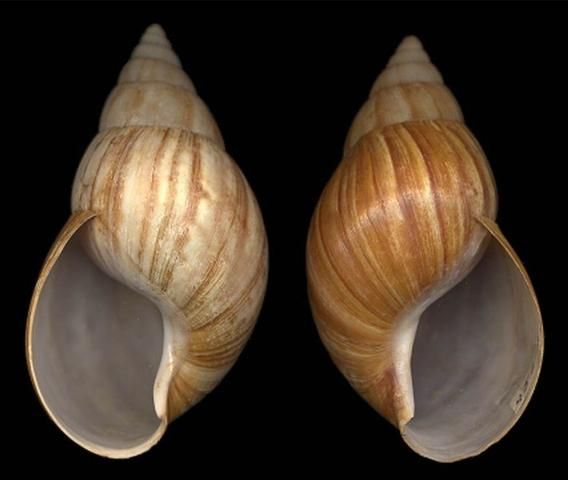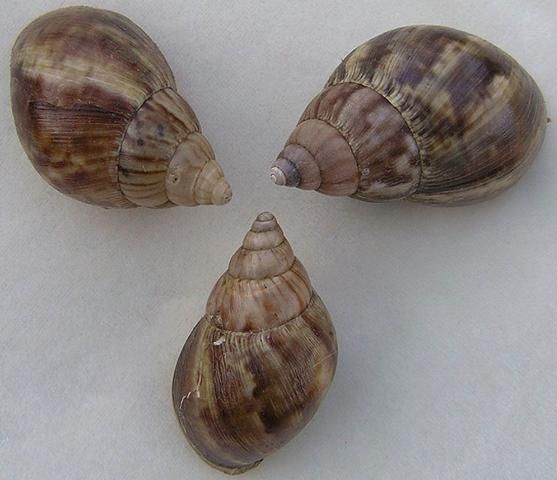The Featured Creatures collection provides in-depth profiles of insects, nematodes, arachnids and other organisms relevant to Florida. These profiles are intended for the use of interested laypersons with some knowledge of biology as well as academic audiences.
Giant African land snail, Achatina (Lissachatina) fulica, is considered by some to be one of the most damaging snails in the world. It has been observed to feed on at least 500 different types of plants, many of them crops. It is thought to have originated in East Africa, but has since spread through many countries in Southeast Asia and islands in the Pacific Ocean, including the Hawaiian Islands. More recently, this mollusc gained access to South America (Brazil) and the Caribbean islands of Martinique, Guadeloupe, Saint Lucia, Barbados and Saint Martin/Saint Maarten. In early September 2011, it was found in Miami-Dade County of southern Florida. This is not the first occurrence of giant African snail in Florida. In 1966, a Miami, FL, child smuggled three giant African snails into south Florida when he returned from a trip to Hawaii. His grandmother eventually released the snails into her garden. Seven years later, more than 18,000 snails had been found along with scores of eggs. It was eventually eradicated, but it took 10 years at a cost of $1 million to eliminate this invader. Florida is now once again faced with an invasion by this snail.
Description
Giant African land snail grows to a large size. It can attain a length of nearly 8 inches (20 cm) and a diameter of 5 inches (13 cm). It is conical in shape, tapering to a distinct point at one end, but rounded at the other (Figure 1). Although varied in appearance, this snail typically is light brown, with dark brown stripes (Figure 2).

Credit: H. Lee

Credit: B. Frank
Like other snails, giant African land snail has a fleshy body that can be withdrawn into the shell. It bears two pairs of tentacles. The larger, upper pairs bear eyes at the tips. It glides along on a long muscular 'foot' that extrudes lubricant in the form of mucus.
Behavior
Giant African snail is most abundant in unnatural (disturbed) areas such as gardens. Typically, they have a daytime resting site and then wander out at night to feed. Adults often return to their resting site in the morning, but immature snails are less likely to do so. They may travel up to 50 feet (1500 cm) in a single night to feed. Like other snails, they are principally active at night and during wet weather (greater than 50% relative humidity). They deposit a trail of mucus (slime) as they travel. They normally seek shaded, sheltered resting locations with high humidity, but can climb trees and walls to rest. During inclement, dry weather they become inactive, a condition called aestivation. They often seek moist soil as an aestivation site, probably as an aid to maintain body moisture because they do not feed while aestivating. During aestivation they may produce a hard covering (called an epiphragm) over the opening of their shell. They may remain in this resting condition for several months, awaiting more favorable weather.
Snails are hermaphrodites, which means that they contain both female and male reproductive organs. Although each snail contains both male and female organs, they rarely self-fertilize; instead, they mate with another individual. During mating, both individuals donate and accept sperm simultaneously. Like most other behaviors, mating normally occurs at night. Egg deposition occurs 1–3 weeks after mating, but then can continue for more than a year. Once mated, each snail can produce about 100 eggs during the first year of life, then 200–1000 the second year. Eggs have a hard shell, measure 1/6–1/5 inch (4.5–5.5 mm) in diameter, and are deposited in the soil. Unmated snails will produce few eggs. Eggs normally are produced at the beginning of the rainy season, and again at the end.
Upon hatching, young snails typically consume their egg shell and organic matter in the soil, remaining in the soil for 1–2 weeks before digging their way to the surface and feeding on decaying plant matter (detritus) and suitable living plants. Initially, they remain close to the site of hatching, but eventually begin dispersing further in search of food. Interestingly, their diet habits change as they mature. The older, larger snails are less likely to feed on living plants than the intermediate-aged individuals, instead scavenging on detritus such as leaf litter and decomposing plant material.
These snails are active over a temperature range of about 48–90°F (9–32°C), but can survive both lower and higher temperatures, sometimes by burrowing into the soil. Based on their distribution elsewhere, giant African snail is thought to have the potential to survive as far north as 40 degrees latitude, which might include areas such as New Jersey and Colorado.
Damage Potential
Despite its documented ability to feed on hundreds of different plants, giant African snail can be expected to do most damage to vegetables, flowers and other ornamental plants, and to annual weeds. However, any succulent plant is at risk, particularly seedlings. The need to change cropping practices or to control these snails once they establish creates additional economic burdens.
Giant African snail also has proven to be injurious by transmitting disease organisms to plants and animals, including humans. It can serve as an intermediate host for rat lungworm, which can cause meningoencephalitis in humans. It also carries a gram-negative bacterium, Aeromonas hydrophila, causing several disease symptoms in people, especially those with compromised immune systems.
Management
Snails favor high humidity. Therefore, elimination of mulch, ground cover and other dense vegetation, wood and stones will deny them a moist, sheltering environment. Reducing the amount of irrigation may similarly deny them the moist environment they prefer. Observing plants at night may reveal the presence of marauding snails, even where there are no signs of their presence during daylight. Snails tend not to move far from their host plants, so if damage is visible it is likely that the snail is nearby.
Snails are susceptible to traps. A board, flower-pot saucer, or unglazed flower pot placed in a shady location can serve as a very suitable refuge for snails, and then the offending animals can be collected by hand-picking during the daylight hours from beneath the refuge, and destroyed. Giant African snail seems to be particularly attracted to banana and papaya fruit, so these can be used as baits to attract them.
Snails often are large enough to be seen easily, so they can be collected by hand. It is important to wear gloves or to use an implement to pick up the snails as some snails can carry diseases transmitted to humans by touch. If you do collect snails, you can kill them by sealing them in a plastic bag and then placing the bag in a freezer overnight. The USDA and Florida Department of Agriculture and Consumer Services are currently carrying out a giant African land snail eradication program in Miami Dade County, and will come out and identify and remove collected snails. They can be reached at Help Line 888-397-1517.
Barriers also can be useful for minimizing damage by snails. Copper foil and screening is believed to react with mollusc slime to create an electrical current that deters them from crossing the barrier. The legs of greenhouse benches or the trunks of trees, for example, can be ringed with copper strips to deter these animals from crossing. Copper foil designed specifically for deterring mollusc movement is available commercially from garden supply centers and catalogs. Although expensive to implement, copper can be used to ring entire gardens to prevent invasion by molluscs. The copper strip will oxidize with time, however, becoming less effective. Similarly, diatomaceous earth can be sprinkled around a garden or planting bed to exclude molluscs, as they dislike crawling over this abrasive particulate material. As is the case with a copper barrier, however, this does nothing to suppress any that are already present, and the diatomaceous earth is easily disturbed by rainfall and irrigation, so it works best in arid environments.
Many formulations of molluscicide are available for purchase, but nearly all are bait products that contain toxicants. They usually kill by ingestion of the bait. None are completely effective because molluscs sometimes learn to avoid toxicants or may detoxify pesticides, recovering from sublethal poisoning. It is good practice to apply baits after a site is watered or irrigated, as water stimulates mollusc activity, increasing the likelihood that baits will be eaten. However, do not water immediately after application of baits. Baits can be applied by broadcast on or around gardens containing susceptible plants. It is best to scatter the bait material, as this will decrease the probability that pets or vertebrate wildlife will find and eat much of the toxic bait and become sick or perish.
Metaldehyde-containing baits have long been useful, and remain available. Although effective, metaldehyde-containing formulations are quite toxic to pets and wildlife, so care must be exercised if this toxicant is applied. Also, it is a good idea to avoid contamination of edible plant such as vegetables with metaldehyde-containing bait.
There are alternatives to metaldehyde. Some molluscicide-containing products include carbamate pesticides (alone or in combination with metaldehyde), as these also may be toxic to molluscs. Newer mollusc baits may contain an alternative toxicant: iron phosphate. Iron phosphate is much safer than metaldehyde and/or carbamates for use around pets and vertebrate wildlife, and also is effective. Other bait formulations contain boric acid as a toxicant. Though not yet thoroughly proven, boric acid-containing baits seem promising for giant African snail control. Regardless of the toxicant, baits should be scattered thinly in and around vegetation, so as to make it unlikely that pets or wildlife will ingest too much of the bait.
Additional Information
Giant African Land Snail, FDACS-DPI: https://www.fdacs.gov/Agriculture-Industry/Pests-and-Diseases/Plant-Pests-and-Diseases/Giant-African-Land-Snail